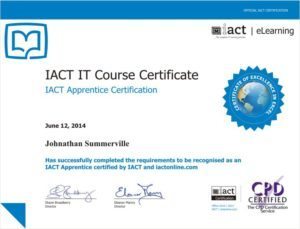Enhance your CV and become interview-ready by learning real-world SQL in this course for non-technical folks and marketers. Mainly using MySQL but applicable for SQL Server
Suitable for All Levels
1 Day Classroom Course
Certification Awarded
Study materials included
Skills You will have at the end of the Course
Understand a MySQL Instance.
Administer a MySQL Instance the Database.
Create a Well Normalised Database.
Create efficient MySQL Queries.
Understand errors as they occur and how rectify them.
Create SQL Queries for Database Driven Applications
Indexing Tables for Better Performance
Good database practices to be followed.
Course overview
This course starts by explaining what a database is, and moving on to creating databases containing tables and views, and stored procedures.
Requirements
None
Certification
At the end of the course, you’ll be Certified by the Irish Academy of Computer Training

Who would benefit
If you a Software Developer, or Web Developer, or a Programmer, then MySQL Database should be one of the Mandatory Databases in your “To Learn” list. If you don’t know MySQL yet or if you are new to any database then this course will benefit you.
Why take the Course
To understand the architecture, components and makeup of the modern PC. To be able to install hardware devices and diagnose installation problems. To understand how Windows configures and works with hardware devices.
Online Option
No
Course curriculum
Module 1 : Getting the Development Environment Ready
- Installation of a MySQL Database Server in Windows.
Module 2 : Beginning with MySQL Basics
- What is a database.
- Creating a Database – CREATE DATABASE
- Creating a Table – CREATE TABLE
- Inserting Values into Table – INSERT INTO
- Retrieving Values from Table – SELECT
- Selecting specific data using a WHERE Clause
- Selecting Data Using AND, OR, NOT
- Selecting Distinct Values from Column – DISTINCT
- Sorting the Data Using ORDER BY
- Limiting the Data Retrieved Using LIMIT
- Updating or Modifying Data in a Table Using UPDATE
- Deleting Data from a Table Using DELETE
- Deleting a Table – DROP TABLE
- Deleting all values in Table – TRUNCATE TABLE
- Understand a Table’s structure DESCRIBE TABLE
- Altering a Table’s Structure – ALTER TABLE
Module 3 : More Complex MySQL
- Selecting Data with a Range – BETWEEN
- Creating Column Aliases – AS
- Selecting Data which has one of Multiple Values – IN
- Using LIKE and WILDCARDS
- Copy Table with INSERT INTO SELECT
- Copy a Table Structure – CREATE TABLE LIKE
- Copy Table with Certain Columns – INSERT INTO SELECT
- Combine the Tables – UNION
Module 4 : Keeping Database in Shape
- PRIMARY KEY
- UNIQUE KEY
- FOREIGN KEY
- NOT NULL
- AUTO_INCREMENT
- DEFAULT
Module 5 : Multi Table Queries
- Using Joins to Combine Tables
- INNER JOIN
- LEFT JOIN
- RIGHT JOIN
- FULL JOIN
Contact us.
We'll reply quickly.
Enquiry
I understand that my personal data is being processed in accordance with the privacy notice and accept the terms and conditions of use.

